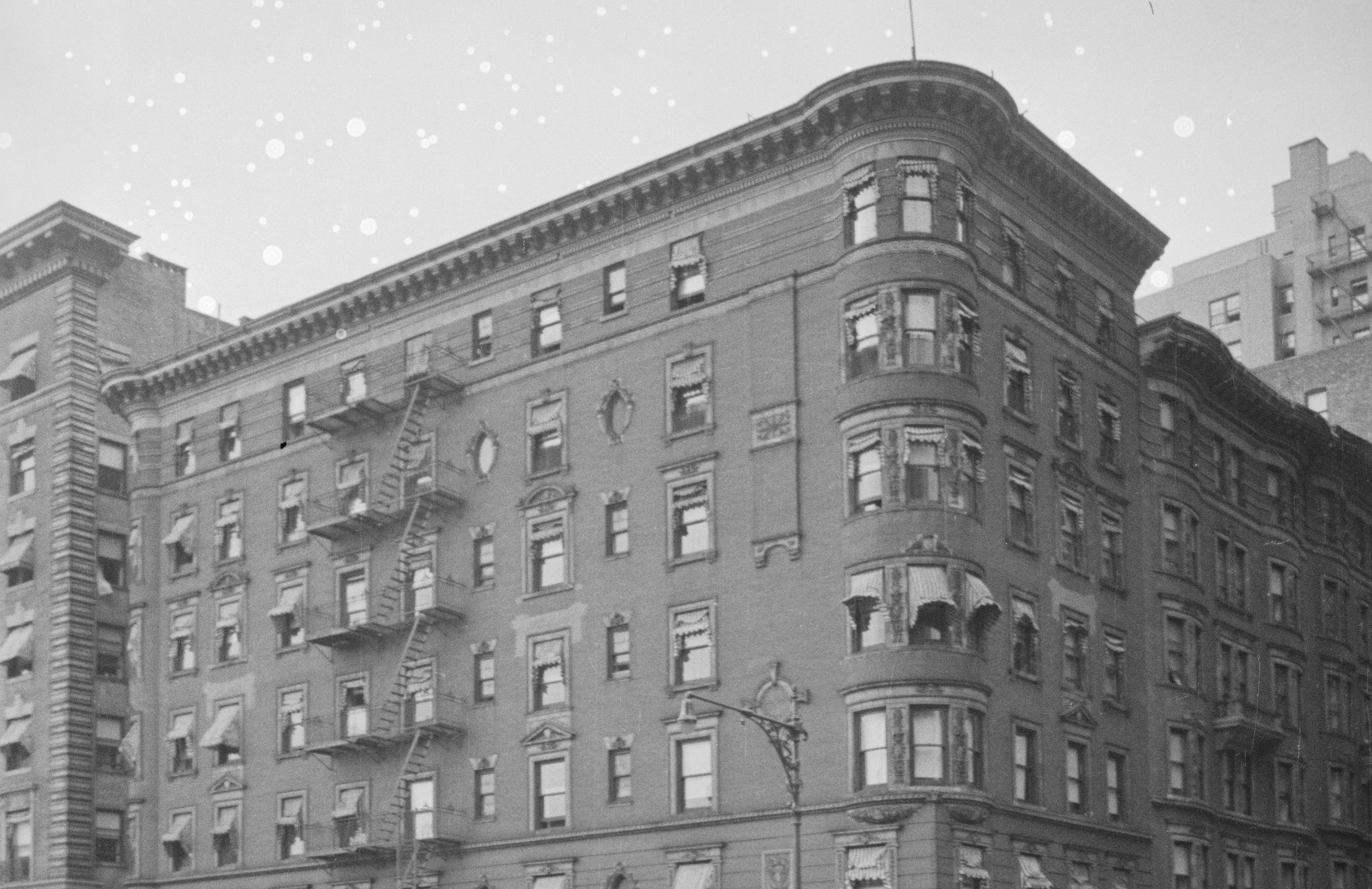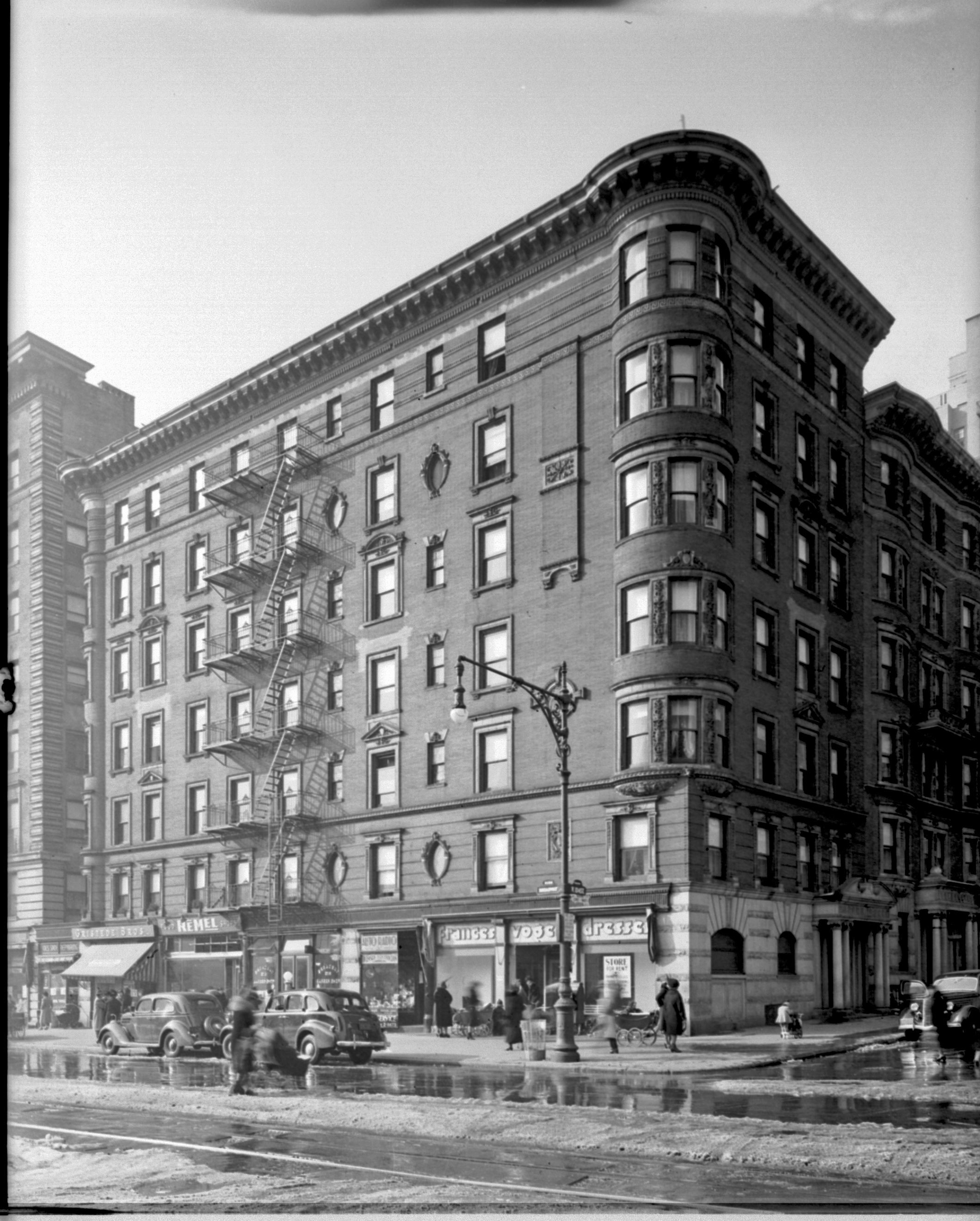
2709-2717 Broadway
by Tom Miller
In December 1897, J. W. Taylor purchased the vacant plot at the southwest corner of the Boulevard (soon to be renamed Broadway) and 104th Street. He was a partner in W. L. Crow & Taylor, real estate operators, which hired architect George Pelham to design a seven-story flat building with stores on the property. The building was completed in the fall of 1898.
Pelham placed six stories of beige Roman brick upon a rusticated limestone and granite base. By locating the residential entrance on the side street, he enabled the placement of stores along the Broadway side. Pelham’s Renaissance Revival design featured elaborate terra cotta designs, including oval windows embraced by cornucopia and round and rectangular panels. The corner became rounded above the second floor, giving it a romantic, turret-like appearance.
The apartments were seven or eight rooms each. An advertisement described them as “all perfectly light” and touted the building’s “electric elevator, electric light, and telephone in each apartment; the best of modern plumbing; porcelain washtubs and sinks; stationary washstand between bedrooms; handsome entrance hall; first-class liveried service.”
That the apartments each had telephone service rather than a telephone operator being posted in the lobby, as was most often the case, reflected the high-end amenities of the building. The “liveried service” referred to the uniformed hallboys and elevator operators (hallboys being on hand to assist with packages, run errands, and such). Rents ranged from $1,000 to $1,200 in 1900 or about $3,325 per month for the more expensive today.
The residents maintained small domestic staffs, like a cook and maid. They also spent their summers in the country. Both situations were reflected in a help-wanted advertisement placed by one resident in the September 2 issue of The Outlook in 1899:
Nurse Wanted for Baby Nine Months Old—Must be a kind, trustworthy and efficient young woman. Address Mrs. William S. Day, Spring Lake N. J. until Sept. 25; after that, 240 West 104th St., New York City.
The man’s son had been committed to an institution, and Pooley “was trying to enlist the sympathy of the judge in order that the boy might get his release,” explained the New-York Tribune.
Among the initial commercial tenants on Broadway was the newly-established real estate office of Brandt & Kirby, which opened in September 1898, and a laundry which was located at 2713 Broadway by 1899. That year in October, it advertised: “Boy—Wanted, strong boy in laundry; salary $4.”
Among the most well-known and respected of the early residents was magistrate John B. Mayo of the Yorkville Court. On November 15, 1900, he and other Democrats went to the Cunard wharf to wish Tammany boss Richard Crocker a bon voyage. Mayo caught a cold in the night air, and a week later, on November 23, The Morning Telegraph reported he “is ill at his home, 240 West 104th Street.”
Judge Mayo recovered and, six months later, was called upon to perform an uncomfortable duty. Earlier in 1901, Mayo had written a letter of introduction of William N. Pooley, a real estate dealer, to Judge Joseph E. Newburger. The man’s son had been committed to an institution, and Pooley “was trying to enlist the sympathy of the judge in order that the boy might get his release,” explained the New-York Tribune.
Shortly afterward, in March, Pooley went missing. His wife filed what today would be a missing person report, but no trace of him was found. Then, on May 2, a body was found in the Harlem River at 136th Street. When the clothing was searched at the morgue, the business card of Judge Mayo was found among the papers. A call was made to the apartment, and Mayo was tasked with identifying the long-dead body.
In 1907 Mayo was appointed Justice of the Court of Special Sessions, and in 1910 he was among the initial directors of the newly-formed New York Probation Association. Not long after that, Mayo and his wife moved four blocks away to the new Allenhurst Apartment building.
In the meantime, in 1902, the Broadway stores were home to J. Simon’s bookstore at 2711, Haynor & Osgood, “paper hanging and interior decorations” at 2715, and the Gardiner Stewart real estate office at 2717. In 1907 the Broadway Barber Shop opened in 2713.
The family of Ruel S. Darling, the president of Darling Brothers Co., lived here by 1905 and would remain at least through 1923. Darling was involved in a tragic incident in the fall of 1905. Ruel Jr. was a student at New York University, and the Darlings were in the stands on November 25 to watch the NYU-Union College football game. The Union team’s star halfback, 19-year-old William Moore, suffered a brutal impact with another player. The New York Times reported, “Moore fell senseless on the gridiron.” The article continued, “As great delay would be occasioned in a wait for an ambulance, Moore was lifted into the automobile of R. F. Darling, No. 240 West 104th street, and whirled away to the hospital at express speed.” Unfortunately, it was to no avail. The athlete died in the hospital later that evening.
It was Mrs. Darling whose name most often appeared in the newsprint. She was involved in numerous societies and charities. On February 15, 1909, for instance, the New-York Tribune reported, “The Friendly Aid branch [of the Tribune Sunshine Society] held a social euchre on February 2, at the home of Mrs. R. S. Darling, No. 240 West 104th street…The ticket money was all given to aid an unfortunate gentlewoman in the Mary Fisher Home.” She was also the corresponding secretary of the Chapin Home for the Aged and Infirm.
Moving into the building around 1908 were Edwin Hatfield Anderson and his wife, the former Frances R. Plummer. Anderson was born in Zionsville, Indiana, in 1861, and the couple was married in 1891. He had been the first librarian of the Carnegie Library in Pittsburgh, Pennsylvania, and had accepted the position of assistant director of the New York Public Library in 1908.
Like Mrs. Ruel S. Darling, Mrs. Elwin Kane Stewart was active in social organizations. In 1921 she was vice president of the National Society of Ohio Women. Also living here that year was Robert Gazlay Stewart, a manufacturer and importer of artificial flowers and feathers (presumably her son). Born in 1898, Robert had attended the Collegiate School and the Horace Mann School before entering Amherst College. In 1923 he married Elsie Bell Senior. The couple was still in the building in 1927.
He said, “I cut E. G. Marshall’s and Burt Reynolds’ hair.
Living here in 1936 was B. Waller Duncan, the president of the Manhattan and Queens Bus Corporation. By that time, the building was decidedly out of style, and in 1940 it was converted to a single-room-occupancy hotel. A second renovation completed in 1954 resulted in five apartments per floor.
In 1964 the Broadway Barber Shop still occupied 2713 Broadway. Owner (and only barber) Kay Demetriou and other barbers in town were doing a booming business because of the current fad brought on by the Beatles. On October 24, The New York Times printed a photograph of 10-year-old Dennis Buckley reading a comic book in the shop, awaiting his turn in the chair. The caption said he “used to admire crew cuts, would put up with an English haircut in the past, but now fights for as much hair as possible.”
Tragedy visited 240 West 104th Street on March 17, 1974. The New York Times reported that the body of 35-year-old Emory Blount had been found in his apartment “with a belt tightened around the neck.”
In 1977, 27-year-old Abdallah Saleh Abdallah immigrated from Jordan with his wife and two children. Around 1981 he opened a cigar store at 2175 Broadway. According to The New York Times to support his family, “Mr. Abdallah kept his shop open from 6 A.M. to midnight seven days a week.”
At around 2:00 on the afternoon of May 12, 1983, barber Kay Demetriou heard what sounded like a gunshot. He rushed next door to the cigar shop and found Abdallah wounded on the floor. He had been shot by one of two would-be robbers. He died in the ambulance on the way to St. Luke’s Hospital. The gunman, 34-year-old Ricardo Rodriguez, was arrested a month later.
In 1992 the Broadway Barber Shop was the oldest barbershop in New York City. That year Demetriou told a reporter from The New York Times that his customers came from “as far as Japan and New Zealand.” He said, “I cut E. G. Marshall’s and Burt Reynolds’ hair. Burt, he’s a very nice man. I had him to my house. I don’t cut his hair anymore. He has a hair-weave, you know. But that’s his own business.” Today Perfect Brows occupies the venerable barber space.
Tom Miller is a social historian and blogger at daytoninmanhattan.blogspot.com
BUILDING DATABASE
Keep Exploring
Be a part of history!
Think Local First to support the businesses currently at 2709-2717 Broadway aka 240 West 104th Street:



